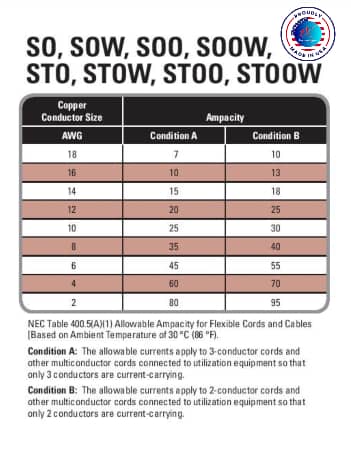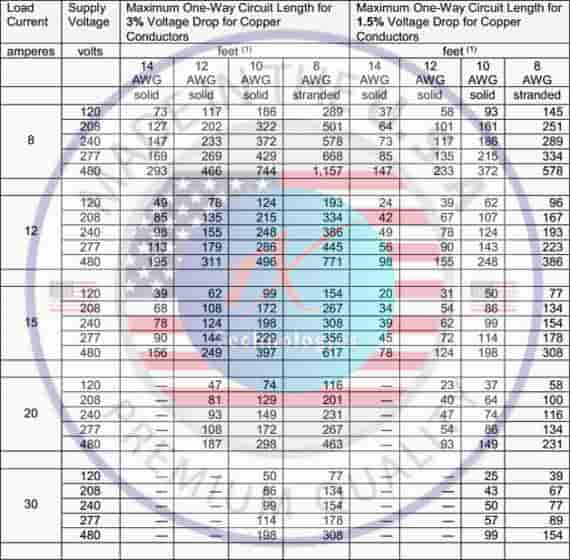1/0 So Cord Ampacity
If you work with electronics or electrical systems, then you already know how important it is to have a safe and reliable way to transfer power from one source to another. There are a lot of different components that go into making a safe and effective electrical system, but one of the most important is the 1/0 so cord ampacity. Understanding what this is and how it works is essential for any electrical professional or DIY enthusiast.
Anyone who has worked with electrical systems before knows the pain points that can come along with it. Whether it's trying to figure out the correct voltage or dealing with components that don't work properly, there are a lot of details that need to be taken care of in order to get the job done right. When it comes to 1/0 so cord ampacity, the biggest pain points typically come from not understanding the basics of how it works and not knowing which components to use in which situations.
So what exactly is 1/0 so cord ampacity? Simply put, it refers to the maximum amount of electrical current that can be safely transmitted through a specific cord or cable. This capacity is determined by a number of factors, including the gauge of the wire, the material it's made from, and the amount of insulation that's used. By understanding these factors and knowing how to choose the right components, electrical professionals can ensure that their systems are safe, reliable, and efficient.
In summary, understanding 1/0 so cord ampacity is essential for anyone working with electrical systems. By knowing what it is and how it works, you can ensure that your systems are safe, reliable, and efficient. Some important factors to keep in mind when working with 1/0 so cord ampacity include the gauge of the wire, the material it's made from, and the amount of insulation that's used.
What is 1/0 so cord ampacity and why is it important?
As an electrical professional, I've seen the importance of 1/0 so cord ampacity firsthand. When you're dealing with electrical systems, safety is always the top priority, and having a clear understanding of how much current can safely be transmitted through a given cord or cable is essential for ensuring that your system is up to code and operating safely. Understanding 1/0 so cord ampacity can help you choose the right components for your system and ensure that you're not putting anyone or anything at risk.
How to Choose the Right 1/0 so Cord Ampacity for Your Needs
When it comes to choosing the right 1/0 so cord ampacity for your needs, there are a few important factors to keep in mind. First and foremost, you need to consider the amount of current that your system will be transmitting, as well as the voltage that it will be operating at. Additionally, you'll need to consider the length of the cord or cable that you're using, as well as the environment that it will be operating in. By taking all of these factors into account, you can choose the right 1/0 so cord ampacity for your needs and ensure that your electrical system is safe, reliable, and efficient.
Factors to Consider When Choosing 1/0 so Cord Ampacity
Some of the most important factors to consider when choosing 1/0 so cord ampacity include gauge, material, insulation, and length. Generally speaking, thicker wires will be able to transfer more current safely, while high-quality insulation will help to prevent electrical interference and ensure that your system is operating effectively. Additionally, the length of your cord or cable will impact how much current can safely be transmitted, so it's important to choose a length that's appropriate for your needs.
How to Maintain Your 1/0 so Cord Ampacity for Optimal Performance
Once you've chosen the right 1/0 so cord ampacity for your needs, it's important to maintain it properly in order to ensure optimal performance and longevity. One important step is to regularly inspect your cords and cables for any signs of wear and tear, such as frayed wires or damaged insulation. Additionally, you should always take care to handle your cords and cables properly, avoiding kinks and tangles that can compromise their performance over time. By following these steps, you can help to ensure that your 1/0 so cord ampacity is operating at its best and delivering safe, reliable power to your system.
Question and Answer
- Q: What happens if you exceed the ampacity of a cord or cable?
- A: Exceeding the ampacity of a cord or cable can cause it to overheat, which can lead to electrical shorts, fires, or other dangerous situations. Always choose the right ampacity for your needs and take care to maintain your cords and cables properly in order to ensure safe and effective operation.
- Q: How is ampacity measured?
- A: Ampacity is typically measured in amperes, which is a unit of electrical current. The maximum ampacity that a cord or cable can safely transmit will depend on a number of factors, including the thickness of the wire, the material it's made from, and the amount of insulation that's used.
- Q: Can you splice a cord or cable in order to increase its ampacity?
- A: In general, splicing cords or cables together is not recommended, as it can compromise the ampacity and safety of the system. Instead, it's better to choose a cord or cable with a sufficient ampacity for your needs, or to use multiple cords or cables in parallel if more current is needed.
- Q: Are there any other factors that can impact ampacity besides the ones mentioned above?
- A: Yes, there are a number of other factors that can impact ampacity, including the temperature of the environment, the presence of moisture or chemicals, and the specific configuration of the cord or cable in question. It's important to take all of these factors into account when choosing the right ampacity for your needs.
Conclusion of 1/0 so cord ampacity
Overall, understanding 1/0 so cord ampacity is essential for anyone working with electrical systems. By carefully choosing the right components and taking proper care of your cords and cables, you can ensure that your electrical system is safe, reliable, and efficient. Whether you're a DIY enthusiast or a professional electrician, taking the time to understand 1/0 so cord ampacity can help you stay safe and get the job done right.
Gallery
LP-Rated Cable | » Standards Informant

Photo Credit by: bing.com / cable table lp rated need standards ampacity
Extension Cord Price/Cost, Power Amps Rating, Custom Types & Lengths

Photo Credit by: bing.com / nec ampacity ecobee3 cords conditioner amperage
Extension Cord Price/Cost, Power Amps Rating, Custom Types & Lengths

Photo Credit by: bing.com / cord amps ampacity cords cable amperage calculator lengths
Ampacity Chart | Home - Electrical | Pinterest | Gauges, Cord And

Photo Credit by: bing.com / ampacity gauges cord
6 Photos Ampacity Table Nec 2017 And Review - Alqu Blog

Photo Credit by: bing.com / ampacity nec chart mm2 conductor conductors wires thhn 1xtechnologies 800pix conduit gland comprehensive correctly capacity calculation load
0 Response to "1/0 So Cord Ampacity"
Posting Komentar